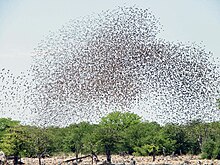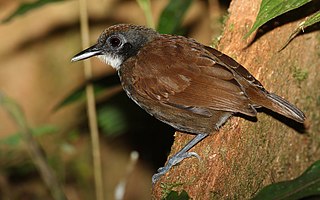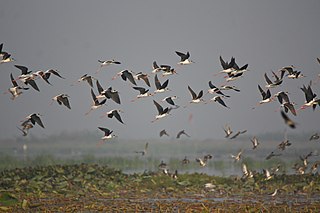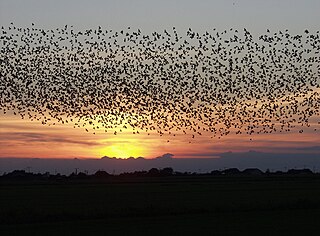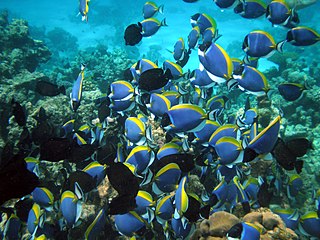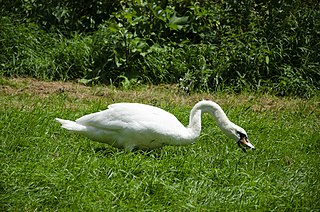Feeding and predation risk trade-off
Vigilance and feeding (both searching for and handling food) are generally mutually exclusive activities, leading to foragers facing a trade-off between energy intake and safety from predation. As time allocated to scanning reduces the time spent feeding, vigilant individuals must devote more time on foraging to obtain the required food intake. [2] This impedes on other activities in their time budget such as mating and prolongs their exposure to predation as foraging occurs away from shelter. [2] When foraging time is limited, vigilant animals are left with a reduced energy intake. [2]
Optimality models can be used to predict foraging decisions of an animal based on costs (predation risk, starvation) and benefits (safety, food), which are also affected by physiology such as hunger levels. [1]
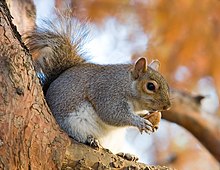
Grey squirrels (Sciurus carolinensis) alter their behaviour according to the relative costs and benefits when foraging in the open. [3] Small food items are consumed immediately to maximise energy intake, as they require little handling time so the cost of predation risk is low. [3] Large items that require a long handling time, and hence time exposed to predators, are carried back to the safety of a tree to minimise predation risk. [3] Although there is an energetic cost to transporting food, large food items have a high contribution to nutrient intake so the cost outweighs the benefits. [3]
The overall predation risk is a function of the abundance, activity and ability of predators to detect the forager, as well as the likelihood that the forager can escape the predator if it is not vigilant. [4] Animals prioritise vigilance over feeding when the predation risk is high. For example, yellow-eyed juncos spend more time scanning for predators when a potential predator, a Harris's hawk (Parabuteo unicinctus), is present compared to when the hawk is absent. [5]
Another factor that influences vigilance is the benefit that is expected from foraging in the absence of predation. [4] This is dependent on the quality of the food as well as the energetic state of the individual. If there is much to be gained from feeding, foragers may forgo vigilance. Similarly, if hungry animals have a higher chance of dying from starvation than from predation, it is more beneficial to sacrifice vigilance to fulfill their energy requirements. When three-spined sticklebacks (Gasterosteus aculeatus) are deprived of food, they prefer to feed in locations with a high density of water fleas. [6] The cost to this choice is that the sticklebacks must concentrate on picking out the prey due to the 'predator confusion effect' where many moving targets make it difficult for predators to pick out individual prey. [6] This choice means that the sticklebacks are less able to scan for predators however the risk of starvation is relatively higher than the risk of predation. [6] Similarly, juncos that have been deprived of food exhibit lower levels of vigilance, instead focusing on rapid feeding which is a behaviour incompatible with scanning. [7]
Habitat and food choice
The state of an animal can change due to its behaviour and vice versa due to the dynamic feedback between foraging, body reserves and predation risk. [1] The feedback can influence an individual's choice of where, when and what to feed on. If the predation risk is so great that an animal must maintain a level of vigilance that drastically inhibits feeding, it may opt for an alternative.
For example, the bluegill sunfish (Lepomis macrochirus) has the choice of foraging on plankton in the safety of reeds or on benthic invertebrates which are a better quality food source. [8] When a predator (the largemouth bass) is present, smaller sunfish spend the majority of their time foraging in the reeds despite this choice reducing their food intake and seasonal growth rate. [8] Sunfish that are too large to be eaten by the bass forage almost entirely on benthos. Although staying in the reeds means a slower growth rate and a longer period of being a size vulnerable to predators, for maximum survival sunfish choose to remain in the reeds feeding on plankton until they reach a certain size and then leave to feed on benthos. [8]
Nocturnal animals alter the timing of their foraging based on the level of light – avoiding feeding when the moonlight is bright as this is when predation risk is highest. [9]
A raised head is the most commonly used indicator of vigilance, as many animals require their heads to be lowered to search for and handle food. [10] Different foods require different handling that can affect the amount of vigilance an animal can maintain. Seeds without husks, for example, require little handling by birds so are rapidly pecked up with the birds head down which is incompatible with vigilance. [11] In situations of high predation risk, animals may choose foods that can be foraged while maintaining vigilance. When dark-eyed juncos (Junco hymenalis) feed in small flocks, they prefer to feed on larger pieces of food than when they are part of a larger flock. [11] As individuals in smaller flocks have a greater need to be vigilant (see more in Vigilance in groups), large pieces of food are more beneficial as they require a longer handling time that can be simultaneously spent scanning, whereas birds feeding on small pieces must intermittently stop foraging to scan their environment. [11]
